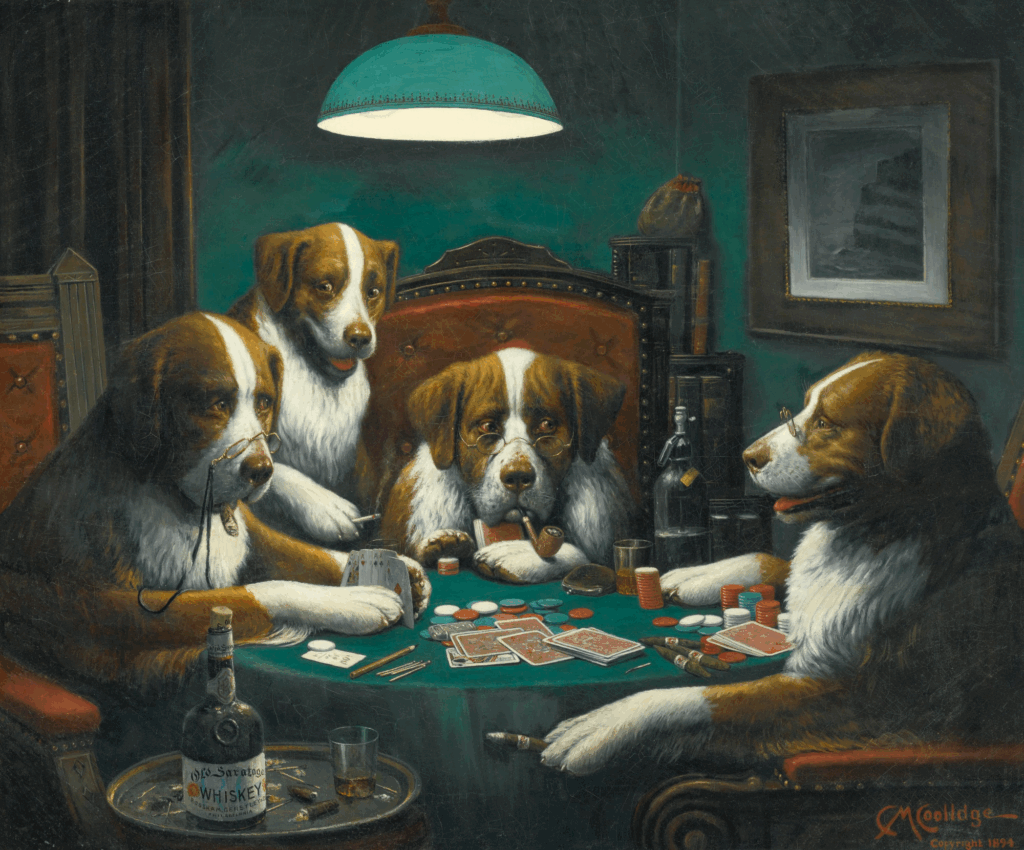Dogs Playing Poker: Where art meets gambling
You might not immediately expect a history lesson from us. But this iconic series of paintings is certainly worth mentioning. Perhaps you have come across these works somewhere?
The origin of iconic art
The idea that dogs exhibited human behavior was groundbreaking for its time. It was seen as cheerful, innovative and humorous. The original painting “Poker Game” from 1894 was therefore the precursor to the later series that would grow into an American cultural phenomenon.
Because then a series of sixteen oil paintings were created commissioned by “Brown & Bigelow” for cigar advertising, plus a painting from 1910. The anthropomorphic dogs were therefore originally used to promote cigars, but were later also printed on calendars and other products, which increased their popularity.
The artist Cassius Marcellus Coolidge left his mark on contemporary art that is still relevant today. Fun fact: The first painting, “Poker Game” from 1894, sold for 658 000 dollars at auction in 2015, which proves that his art is still popular.
Series consists of 18 paintings
The eighteen paintings all feature animated dogs, of which the eleven with dogs at a card table have become famous in the US as home decoration.
Original painting:
- “Poker Game” (The original painting from 1894)

The “Brown & Bigelow” series painted between 1903 and 1906, some paintings explicitly mention the year:
- “A Bachelor’s Dog” – reading the mail
- “A Bold Bluff” – poker (originally titled Judge St. Bernard Stands Pat on Nothing)
- “Breach of Promise Suit” – testifying in court
- “A Friend in Need” (1903) – poker, cheating
- “New Year’s Eve in Dogville” – ballroom dancing
- “One to Tie Two to Win” – baseball
- “Pinched with Four Aces” (1903) – poker, illegal gambling
- “Poker Sympathy” (1903) – poker
- “Post Mortem” – poker, camaraderie
- “The Reunion” – smoking and drinking, camaraderie
- “Riding the Goat” – masonic initiation
- “Sitting up with A Sick Friend” (1905) – poker, gender relations
- “Stranger in Camp” – poker, camping
- “Ten Miles to a garage” – travel, car trouble, teamwork
- “A Waterloo” (1906) – poker – (originally titled Judge St. Bernard Wins on a Bluff)
A similar work followed in 1910:
- “Looks Like Four of A Kind”
Coolidge also ventured into showing dogs at the pool table in the work “Kelly Pook”, which built on the original idea but is completely separate from the “Dogs Playing Poker” series.
A playful and satirical portrayal of the casino industry
This art works accessible through the joyful approach where the friendly aspect of poker is emphasized instead of the competitive side. It reminds us of the essence of playing a game among friends.
These paintings playfully suggest that the joy of playing a game should take precedence. Fun should come from the challenge and the enjoyment itself, and each player should decide for themselves when it remains enjoyable and responsible.
By using dogs with human features, these paintings nostalgically symbolize classic poker nights with an emphasis on interaction, atmosphere and social interaction.
A humorous and iconic status through the years
These paintings have become very popular to be used as decoration in cafes, arcades and casinos, and even in living rooms. These paintings can be obtained in various sizes, which makes them very accessible to the general public. They also appear regularly in films and series. Due to the playful nature of these works and the absurdity of dogs playing poker, the message is pure entertainment.
References can also be found in some episodes of “The Simpsons”, for example when Bart walks past famous works of art during a scene and Homer suddenly reacts in surprise: “They’re dogs and they’re playing poker!”
The painting we get to see is “A friend in Need” from 1903. The Simpsons are known for incorporating many hidden messages into their episodes and teaching viewers about history and American culture. This characterizes that these works of art have acquired a humorous and iconic status that still stands today.


